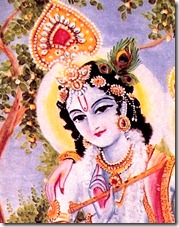 “Yogis cannot reach Krishna, but for pure devotees like mother Yashoda, Krishna is already caught.” (Shrila Prabhupada, Shrimad Bhagavatam, 10.9.9 Purport) “Yogis cannot reach Krishna, but for pure devotees like mother Yashoda, Krishna is already caught.” (Shrila Prabhupada, Shrimad Bhagavatam, 10.9.9 Purport)With the hustle and bustle that comes with the feverish pursuit to procure enough wealth and provisions to support oneself and a family, even a holiday turns into a time of turmoil, adding pressure to a day that is meant to relieve it. The increase in obligations is especially true with the Thanksgiving holiday. Though carrying issues relating to travel and the comingling with family members you may not have seen in a long time, Thanksgiving is meant to be a day of prayer and remembrance, a time to give thanks to the Almighty for the bountiful gifts he heaps upon us. Thanksgiving brings the inevitable question of what we are thankful for. For the spiritualist trying to reach a better end in both this life and the next, there is one aspect to their practices that provides endless gifts, which can be appreciated every day, including on Thanksgiving.  The first Thanksgiving celebrated a bountiful harvest that resulted from a major shift in the way food was produced inside of a small community. Settlers to what would be known as the New World had a difficult time in the beginning. There were very few colonists who had fled England for the “greener” pastures of America, but when they arrived after a long boat ride conditions were so unexpectedly harsh that many of them died during the first winter. To further add to their troubles, the colonists found that their food production was quite sparse, for everything was placed into a common store, to be shared by all the members of the community. The first Thanksgiving celebrated a bountiful harvest that resulted from a major shift in the way food was produced inside of a small community. Settlers to what would be known as the New World had a difficult time in the beginning. There were very few colonists who had fled England for the “greener” pastures of America, but when they arrived after a long boat ride conditions were so unexpectedly harsh that many of them died during the first winter. To further add to their troubles, the colonists found that their food production was quite sparse, for everything was placed into a common store, to be shared by all the members of the community.The governor of this group decided to shift gears, assigning a plot of land to each family, with the fruits of labor remaining in their possession. As a result, the next harvest was so large that not only was the starvation problem solved, but free trade with the neighboring native Americans could take place as well. Deciding that the harvest was too grand to let pass without commemoration, the Pilgrims held a grand feast, where there was an overwhelming feeling of gratitude. They thanked the Lord for their ability to eat and survive. The tradition then continued annually even into the founding of the United States of America, with George Washington, the first president, declaring the holiday be dedicated to serving the Supreme Lord, a time to give thanks for all that He has given.
In the Vedic tradition, the oldest system of spirituality known in the world, there are different ways to reach the Supreme Absolute Truth, the source of everything. In any endeavor, there are multiple avenues one can travel down to reach their desired destination. Usually the one that is the simplest to implement is considered the best, but sometimes the simplest doesn’t equate to the easiest to accept. For instance, in weight loss, the easiest option to implement is a reduction in eating. Just don’t eat as much as you are now and you will lose weight. While reducing food intake is easy, accepting the option is difficult, for the individual is accustomed to act otherwise, especially when there are culinary delights available at every corner. Instead of curbing eating directly, roundabout options, such as exercise, diets involving specific foods, and tight controls on the combination of foods consumed, are accepted. For realizing God, there is one simple and surefire method. This option is the easiest to implement but the most difficult to accept. Because this option is available to the most number of people, God is represented fully within it. The other avenues only have God represented partially and thus only bring the Lord’s partial association. A famous incident documented in the Shrimad Bhagavatam The Bhagavatam states that the Supreme Absolute Truth, the Personality of Godhead Himself, descended to earth around five thousand years ago in Vrindavana If we are not our body, then surely someone who is the fountainhead of all spirit and matter cannot be the same as His body when He comes to earth. The body has a strong influence, however, which operates through the illusory energy known as maya. Since we living entities are affected by maya, how can the Supreme Lord have the same defect? Either He is subject to maya also - which thus makes Him equal to us - or the listed incarnations aren’t really God but just some exalted personalities who had extraordinary abilities.
If God stays above matter and doesn’t require self-realization when coming to earth, why even make an appearance? Ah, here is where the opportunity for giving thanks comes in. In the roundabout methods of spirituality, different aspects of the Supreme Lord are uncovered. Even an atheist is a kind of spiritualist, though they don’t know who God is or that He exists. Rather, the atheist recognizes Krishna’s external energy expansion of maya, or material nature. Even in the theory of evolution, which is seen as the antithesis of the spiritual doctrine, a higher power is acknowledged. That stronger force is nature, which assumes the responsibility for the purported changing in the species. Even though such theories are based in ignorance, there is still an acknowledgement of one of Krishna’s energies. Since the Lord has no personal presence in the material energy, His personal association is denied such followers. The jnanis and yogis connect with aspects that have more of Krishna’s influence. Instead of seeing material nature as the cause, jnanis consider the impersonal spiritual energy known as Brahman as the highest force. Think of how each individual has a spark of life inside of them that guides their activities. Then carry that same discernment across every autonomous being, from the tiny ant all the way up to the large elephant. In this way we see that there is a total collection of the spiritual energy, almost a singular energy in a sense. This force is known as Brahman, and it is beyond the dualities created by maya. The jnanis, through study of Vedanta philosophy, worship this energy. Though Brahman is pure spirit, it again lacks Krishna’s personal presence. The yogis try to catch Krishna through His feature of Paramatma, which is the plenary expansion residing within the heart next to the individual soul. With Brahman the sum collection of energy is recognized, and with the Paramatma the localized aspect is honored, but in either case Krishna’s transcendental features are not noticed. Brahman and Paramatma can be described as nirguna, or without attributes, for the spiritualist connecting with these features doesn’t notice the qualities of sweetness belonging to the Personality of Godhead. God isnirguna in the sense that He never possesses material attributes, but at the same time He has spiritual features that can appear contradictory. Krishna is both formless and with form. He has eyes and doesn’t. He has legs and at the same time doesn’t.  How can the human brain make light of these contradictions? The Supreme Personality of Godhead, Bhagavan, in His forms known as saguna, or with attributes, descends to earth every now and then to show the devoted souls what it means to have spiritual attributes. As Krishna, the Lord came to Vrindavana in His original form, one which was full of sweetness. The benefit of Bhagavan’s association is that anyone can connect with Him. Practicing meditational yoga and studying Vedanta are very difficult, thus the two disciplines are exclusive. Their necessary requirements automatically prohibit entry. The jnani must be very intelligent, capable of understanding high logic. The yogi must be renounced, capable of sitting in meditation for hours on end and blocking out the distractions of material life. How can the human brain make light of these contradictions? The Supreme Personality of Godhead, Bhagavan, in His forms known as saguna, or with attributes, descends to earth every now and then to show the devoted souls what it means to have spiritual attributes. As Krishna, the Lord came to Vrindavana in His original form, one which was full of sweetness. The benefit of Bhagavan’s association is that anyone can connect with Him. Practicing meditational yoga and studying Vedanta are very difficult, thus the two disciplines are exclusive. Their necessary requirements automatically prohibit entry. The jnani must be very intelligent, capable of understanding high logic. The yogi must be renounced, capable of sitting in meditation for hours on end and blocking out the distractions of material life.To connect with Bhagavan one must follow bhakti-yoga, which is available to every person, even if they are seemingly materially entangled. The residents of Vrindavana five thousand years ago weren’t jnanis or yogis, and they had never practiced self-realization. Nevertheless, they got to catch Krishna, to hold Him in their arms and bask in His sweet vision. How was this possible? They practiced bhakti, though they weren’t cognizant of the fact. Through many austerities from previous lives and a pious attitude guiding their activities, these residents were fully deserving of Krishna’s company. As they weren’t jealous of Him, why wouldn’t the Lord choose their land as the place to come and enact His pastimes?  The residents of Vrindavana were certainly thankful for Krishna’s association, and the people who hear from the Shrimad Bhagavatam can share the same sentiments. One time, the child Krishna broke a pot of butter belonging to His mother Yashoda. When she came upon the broken pot, she knew that it was Krishna’s work, for He was angry that she had gotten up while feeding Him to tend to a pot of boiling milk on the stove. When she returned, Yashoda saw the broken pot and then found the culprit Krishna feeding butter and yogurt to monkeys. Delighting in the scene, Mother Yashoda was ready to catch her son and punish Him for His transgression. The residents of Vrindavana were certainly thankful for Krishna’s association, and the people who hear from the Shrimad Bhagavatam can share the same sentiments. One time, the child Krishna broke a pot of butter belonging to His mother Yashoda. When she came upon the broken pot, she knew that it was Krishna’s work, for He was angry that she had gotten up while feeding Him to tend to a pot of boiling milk on the stove. When she returned, Yashoda saw the broken pot and then found the culprit Krishna feeding butter and yogurt to monkeys. Delighting in the scene, Mother Yashoda was ready to catch her son and punish Him for His transgression.Seeing Mother Yashoda with her whipping stick in hand, Krishna started to run away, pretending to be afraid. Though yogis and jnanis can’t catch Krishna, Mother Yashoda, a cowherd woman without much speed herself, was able to catch the Supreme Lord and bind Him in her motherly affection. The Lord allowed His dear mother to catch Him and execute her motherly duties, which gave her so much pleasure. From that association both sides felt tremendous delight, for the natural positions of the Supreme Lord and His devotees On Thanksgiving we can give thanks to the Supreme Lord for having descended to earth to engage in these pastimes. Karma, yoga and jnana are available to try, but only through bhakti will we get Krishna’s association. The Shrimad Bhagavatam is a bhakti-shastra, a scriptural work focused on devotional service In Closing: Seeing mother’s presence Krishna started to run, Knew He did something bad, with mother enjoyed the fun. A whipping stick in her hand to punish she took, Trouble catching son, for not was she fleet afoot. Materialist the presence of God can never see, Brahman and Paramatma for jnani and yogi. But Yashoda caught Krishna by bhakti following, With ropes of affection her young son binding. Thankful we are for that scene so pleasurable, Krishna caught by mother’s love, a pastime so delightful. |
Search This Blog
Thursday, November 24, 2011
Thanksgiving 2011
Subscribe to:
Post Comments (Atom)

No comments:
Post a Comment